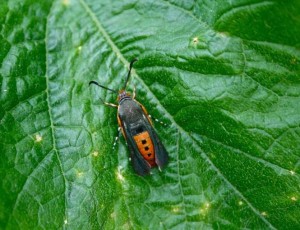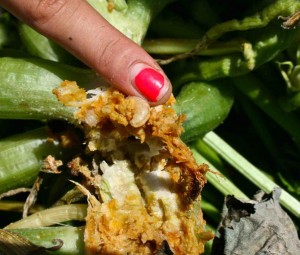Squashing a squash pest
by Laura Schumm, Community Kitchen Garden Research Intern, Lewis Ginter Botanical Garden
So far this season here in the Lewis Ginter Community Kitchen Garden, the squash vine borer has been one of our most destructive pests. These pesky insects can cause major damage in your garden before you realize what’s going on; and they are gradually destroying our squash crop. We have been pulling up a dozen or so plants every other day. The first sign of trouble came in the form of sudden wilting of some of our squash plants. Upon close inspection we noticed small holes in the stem and an orange saw dust-like substance called frass, or the byproduct of insect feeding. By this point it was too late and the damage had been done. Not long after that the entire stem would rot and the plant would die. This pest is almost impossible to control once an infestation has begun.
The vine borer adult is a wasp-like moth that measures about ½ inch big. They have dark metallic forewings and an orange abdomen with black dots. They lay small circular brown eggs at the base of the squash stem (and sometimes other places) in late June or early July. The eggs hatch in approximately one week, and fat white larva with brown heads begin to bore their way into the vulnerable stem destroying the vascular system of the plant causing it to wilt and eventually die.
The best way to manage the squash vine borer is to prepare before it strikes. IPM, or Integrated Pest Management, methods produce the best results. IPM is a process used to manage and control pests using three basic steps: inspection, identification, and treatment. Gardeners should thoroughly inspect plants by hand to look for insects at any stage. If eggs, larvae, or adults are spotted, the next step is to positively identify the pest (or perhaps beneficial insect). Once the insect is identified the proper treatment can be chosen. The least hazardous method of treatment should always be used first.
The squash vine borer is a difficult pest to prevent and manage. The adult vine borer can be elusive, and yellow trap pans are one way to detect their presence. Just fill a yellow container with water; the adult vine borer is attracted to yellow-like the squash blossoms and they will get trapped in the water. This is only an indicator of their presence not a way to eradicate the pest. Some gardeners use panty hose around the base of their squash stems in hopes of deterring the vine borer from laying its eggs. Row covers can also be used for this reason but must be removed once the plant flowers so that pollination can occur.
If you find a plant that are infested you can try injecting Bacillus thuringiensis (BT) into the stem with a hypodermic needle. Then gently slice the stem open and remove the vine borer larva. Cover the cut with soil to encourage new root growth. This treatment could be very difficult if you have a large squash crop with a major infestation. All infested plants should be destroyed, not composted.
Here in the Lewis Ginter Community Kitchen Garden, we did lose many of our squash plants before their time, thanks to the vine borer. But we decided to leave plants that showed signs of healthy new growth for a while longer and many produced fruit for a few more weeks. By now we have pulled up almost all of the squash to make room for fall crops like cabbage, broccoli, cauliflower, and kale.
In addition to squash and zucchini vine borers will also attack pumpkins and gourds — and luckily we haven’t planned those for later in the season. Interestingly, vine borers are not known to attack cucumbers and melons, and ours have been safe so far.
Works Cited
Ball, Jeff. Garden Problem Solver. Emmaus: Rodale Press, 1988. Print.
Hahn, Jeffrey and Suzanne Burkness. “Squash Vine Borer Management in Home Gardens.” 2012. University of Minnesota Extension. Web. 7 August 2012.
Klass, Carolyn. “Squash Vine Borer.” 1995. Insect Diagnostic Laboratory Cornell University. Document. 6 August 2012.

